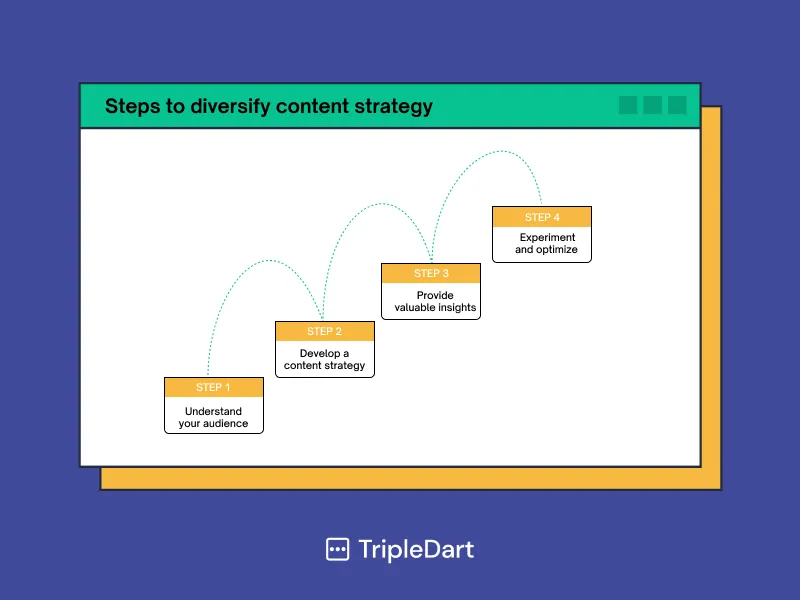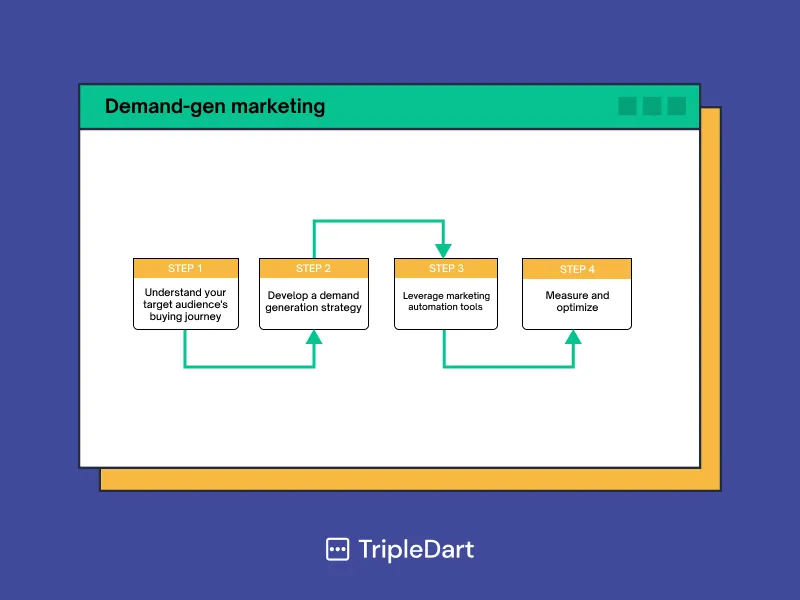Once upon a time, B2B content marketing was a straightforward endeavor. But today's fiercely competitive digital landscape has become a high-stakes game for B2B marketers and enterprises where only the most innovative B2B marketing strategies thrive
Ignoring the importance of staying on top of content marketing trends could lead to dire consequences. Did you know that according to the CMI, 32% of marketers think their content creation workflow is fair or poor?
By drawing B2B content ideas from successful campaigns, you can unlock a treasure trove of ingenious content marketing ideas. These companies have cracked the code to engage their target audience and drive impressive results.
Research shows that B2B companies with well-executed content campaigns experience a staggering 62% increase in leads. So, let’s explore the year's most promising B2B content marketing ideas and revolutionize your B2B content marketing approach.
Content Marketing has become a vital strategy for brands to position themselves in a crowded B2B space. However, with the limited, mundane formats of content, how can B2B brands experiment and create tangible results? Let’s explore it here.
Your audience is facing various challenges and actively seeking solutions. To engage them effectively, it's crucial to diversify your content strategy and deliver it across different platforms. This B2B content idea allows you to attract new audiences, keep your current ones engaged, and take control of your customer journeys.
Here's a step-by-step process to achieve this:

Conduct thorough research to identify your target audience's needs, pain points, and preferences. This will help you create content that resonates with them.
Based on your audience research, create a content strategy encompassing different formats, such as blog posts, videos, podcasts, infographics, webinars, and more. This variety will cater to learning styles and provide valuable information in various formats.
Focus on creating content that educates, informs, and solves problems for your audience. Prioritize value over promotional messaging. Demonstrate your expertise and establish thought leadership through in-depth analysis, case studies, industry trends, and actionable advice.
Continuously monitor the performance of your content across different channels and formats. Analyze metrics like engagement, conversions, and social shares to determine what resonates best with your audience. Adapt and optimize your content strategy accordingly.
ChatGPT has been the talk of the town. But did you know that there are AI-powered Chrome extensions offering endless content creation possibilities. Platforms like There's an AI for That are making things easier for B2B content. Leveraging AI in B2B content marketing can bring numerous benefits, from enhancing efficiency and personalization to gaining valuable insights. Here's how you can harness it:
Use AI-powered content generators to create initial drafts or outlines for blog posts, articles, and social media updates. These tools analyze vast amounts of data and generate relevant content ideas based on specific keywords or topics. While human creativity and editing remains crucial, AI can provide a starting point or inspiration.
AI allows for advanced data analysis and segmentation, enabling you to gain deeper insights into your target audience. Use AI-powered analytics platforms to analyze customer data, including demographics, behavior patterns, and preferences. This information helps tailor your content to specific audience segments, ensuring it resonates with their needs and interests. AI-powered personalization tools can also deliver customized experiences by dynamically presenting relevant content based on user behavior.
Integrate AI-driven chatbots and virtual assistants on your website and social media platforms. These tools can respond instantly to customer queries, offer personalized recommendations, and guide visitors through the buyer's journey. Automating customer interactions enhances user experience, improves engagement, and frees up your team's time for more strategic tasks.
AI-powered SEO tools can assist in keyword research, competitive analysis, and content optimization. These tools use machine learning algorithms to identify keyword trends, analyze competitor strategies, and suggest optimization techniques. You can enhance your website's visibility, improve search rankings, and drive organic traffic to your content.
AI enables you to make data-driven decisions by leveraging predictive analytics. AI algorithms analyze historical data to identify patterns, predict future trends, and recommend content strategies. You can gain actionable insights into content performance, audience behavior, and conversion rates by leveraging AI-powered analytics platforms. This information empowers you to optimize your content marketing efforts for better results.
The shift from lead generation to demand generation is imperative in the dynamic landscape of content marketing. This strategic transition acknowledges the evolving customer journey, focusing on building brand awareness, nurturing long-term relationships, enabling sales teams, and measuring ROI beyond lead quantity. By providing valuable and educational content at every stage of the customer journey, content marketers establish thought leadership, generate demand, and foster brand loyalty. This comprehensive approach ensures sustained business growth and aligns content efforts with today's buyers' changing needs and expectations.

Gain insights into your audience's purchasing process, pain points, and information needs at each stage. This will help you craft content that aligns with their needs throughout the sales funnel.
Create a holistic strategy incorporating content marketing, email marketing, social media advertising, lead nurturing, and other relevant tactics. Ensure your messaging is consistent and tailored to your audience's needs and interests.
Implement marketing automation tools to streamline and scale your demand generation efforts. Use features like lead scoring, personalized email campaigns, and behavior tracking to nurture leads effectively.
Track key performance indicators (KPIs) such as lead conversion rates, customer acquisition costs, and return on investment (ROI). Continually analyze the data to identify areas for improvement and optimize your demand generation campaigns.
SEO is now more about search intent-based content rather than keyword-rich content in B2B content marketing. To improve the quality of your SEO efforts, follow these steps:
Identify relevant keywords and phrases that align with your target audience's search intent. Use keyword research tools to uncover high-volume, low-competition keywords that can drive organic traffic to your website.
Optimize your website's meta tags, headers, URLs, and content to align with your target keywords. Ensure your content provides value, is well-structured, and incorporates relevant keywords naturally.
Develop a link-building strategy to acquire authoritative backlinks from reputable websites in your industry. Create valuable content that others will naturally want to link to, and actively reach out to industry influencers or thought leaders to foster collaborations and guest posting opportunities.
Regularly monitor your website's SEO performance using analytics tools. Analyze data on organic traffic, keyword rankings, and bounce rates to identify areas for improvement. Adapt your SEO strategy based on the insights gained to enhance your website's visibility continuously.
Owned media assets like your website, social media channels, and user-generated content offer valuable opportunities to engage your audience and amplify your brand. Follow these steps to leverage them effectively:
Ensure your website is user-friendly, mobile-responsive, and optimized for lead generation. Create a consistent brand experience across your social media profiles and regularly update them with valuable content.
Actively engage your audience by encouraging them to generate content related to your brand, products, or industry. Run contests, ask for testimonials, and provide incentives for customers to create and share user-generated content.
Select the best user-generated content and feature it on your owned media assets. This helps build social proof, fosters brand advocacy, and encourages others to participate. Promote user-generated content through social media campaigns, email newsletters, and your website.
Regularly monitor user-generated content related to your brand and engage with your audience. Respond to comments, provide feedback, and show appreciation for their contributions. This fosters community and strengthens your brand's relationship with its customers.
Guest blogging is often perceived as solely created to obtain backlinks. However, it is possible to source high-quality guest blog content from customers, relevant experts, and industry influencers.
HubSpot stands out as a great example for effective guest blogging. Their blog features several guest posts written by experts from sales, marketing, and more who provide valuable insights to help marketers build successful businesses.
The key to successful guest blogging lies in finding influencers who align with your brand, possess relevant expertise, and are not direct competitors. Establishing a mutually beneficial partnership opens the door to a wealth of B2B content marketing ideas from your guest content writers. By collaborating with these experts, you can tap into their knowledge, leverage their unique perspectives, and provide your audience with valuable content that resonates with their needs and interests.
Have you ever considered the consequences of your target audience not doing business with you? What's truly at stake? Evaluating whether you have enough content addressing this aspect of the customer journey is essential.
Often, marketers become so focused on highlighting their products' or services' benefits that they overlook the importance of addressing the potential downsides of not having it. Let's look at an example from Testlio, a QA testing company. They created a blog post that sheds light on the costs associated with software bugs, showcasing how it can lead to poor customer experience and extreme distrust.
Suppose you follow the StoryBrand philosophy, where your customer is the story's hero. In that case, it's crucial to acknowledge that what people want to avoid plays a significant role in buying decisions. Therefore, paying attention to this aspect of your content is vital.
Consider the potential downsides of not choosing your product and taking a risk. Incorporate these B2B content marketing ideas into various blog posts, webinars, and emails. By addressing these risks head-on, you can emphasize the pain point they may be unaware of, and position your product as the solution that helps them avoid those adverse outcomes.
Do you want content that highlights expertise and knowledge?
Partner with a content marketing agency for your B2B business. Leveraging an agency’s expertise and experience can help you craft and execute successful content strategies.
B2B Content Marketing agencies like TripleDart can bring fresh perspectives and creative ideas, injecting new life into your content and helping it stand out in the competitive landscape. We stay current with industry trends and best practices, ensuring your content remains relevant and practical.
Additionally, we also provide cost and resource efficiency. You can access a team of skilled professionals and advanced marketing tools without in-house recruitment and training.
Further, TripleDart’s diverse client experiences enable us to offer innovative solutions that captivate your target audience.
No matter the B2B content marketing ideas, you need a trustworthy team of content experts to fuel your B2B marketing campaigns. Our writers and strategists are ready to adapt to the ever-changing B2B content marketing landscape. Are you?
Talk to us now!
Content is the heart of B2B Inbound Marketing. A content strategy is a plan that outlines what content you will create, how you will create it, and how you will distribute it.
Here are some steps to develop a content strategy:
In 2025, B2B content marketing is set to become even more diversified and personalized. Brands will use a mix of blog posts, videos, podcasts, and infographics across different platforms to engage their audience. Leveraging AI in content creation and optimization will be key, making content more relevant and tailored to individual audience needs. Additionally, there will be a stronger focus on demand generation over lead generation, emphasizing building brand awareness and nurturing long-term relationships. The use of marketing automation tools and analytics will become standard practice for optimizing content strategies and measuring success.
To kick off your B2B content marketing, start by understanding your target audience and their needs. Create diverse and engaging content that addresses these needs across various platforms. Utilize SEO to ensure your content is easily found by those looking for solutions you offer. And don't forget to analyze and refine your strategy based on performance data.
For expert guidance and to elevate your content marketing efforts, consider partnering with TripleDart. We specialize in crafting and executing bespoke B2B content strategies that resonate with your audience and drive results. With TripleDart's expertise, you can navigate the complexities of content marketing and focus on what you do best.
Talk to us now!
Join 70+ successful B2B SaaS companies on the path to achieving T2D3 with our SaaS marketing services.

































